Vétheuil to Jambville
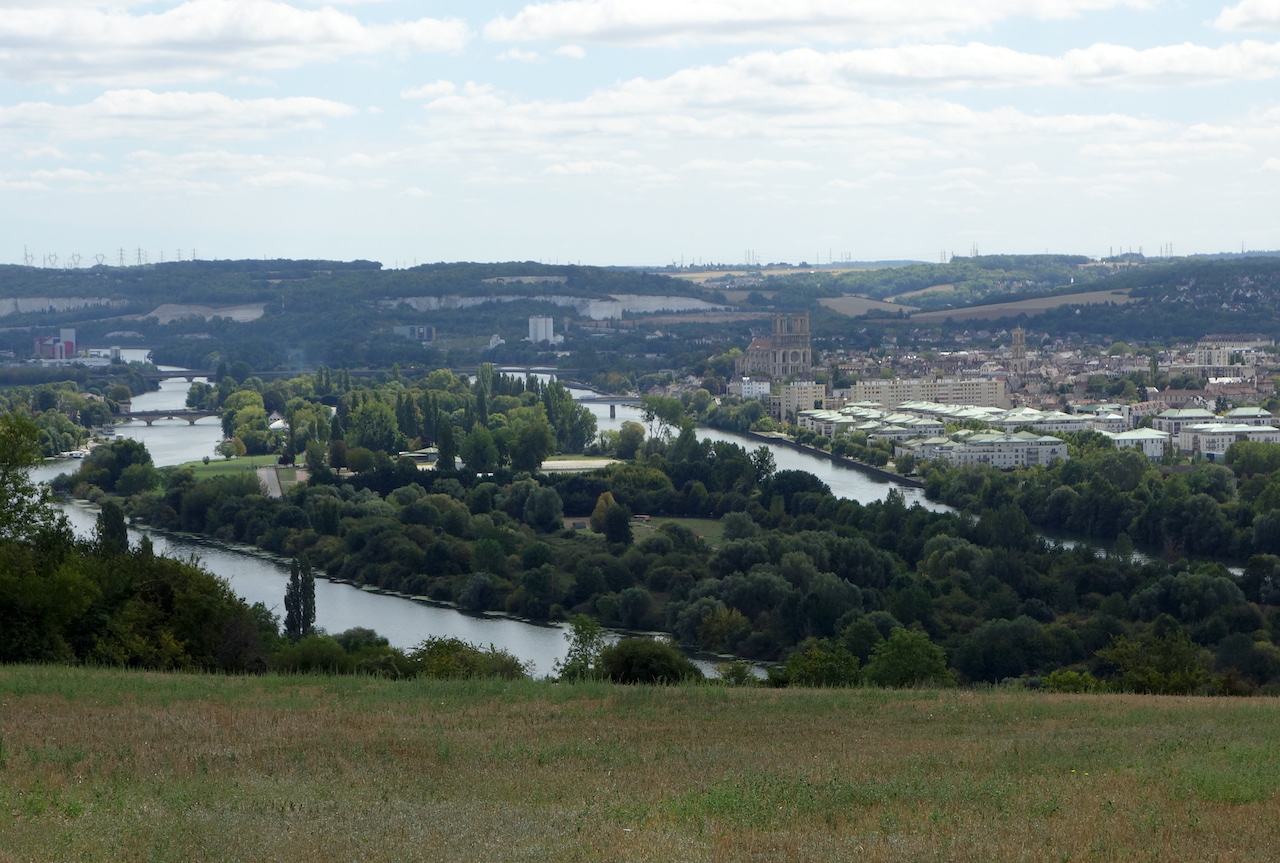
Île-de-France
7. Vétheuil to Jambville
Medium
6h30
24,2km
+588m
-498m
Step
Embed this item to access it offline
You leave the Seine valley for the south of the French Vexin; Walking in forests alternating with crossings of cereal crops in a hilly landscape and a sometimes flat relief. The history of the priory of Saint-Martin-la-Garenne will arouse your curiosity. In Fontenay-Saint-Père you will not be able to visit the castle of Mesnil, whose access is closed, but you will be able to discover the church and the superbly restored wash houses. You will end your stopover at Jambville castle, which has become the National Training Centre for Scouts and Guides of France.
8 points of interest

Église Notre-Dame de Vétheuil - Association Colomban en Brie TouristNotre-Dame Church in Vétheuil
The church of Notre-Dame de Vétheuil surprises by its size, its plan with double collaterals and its particularly rich and varied furniture. It stands out from the village churches of the French Vexin, because Vétheuil is in the Middle Ages a village of some importance. If Merovingian sarcophagi have been found, the first constructions are attested in the 12th and 13th centuries, then in the 16th century. The western portal in Renaissance style is remarkable.
At the tip of the new cemetery remains a very beautiful cross pattée, known as the Cross of Jerusalem or Maltese Cross.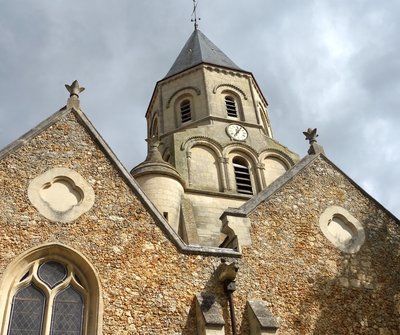
Clocher de l’église Saint-Martin à St-Martin-la-Garenne - Association Colomban en Brie TouristPrieuré de Saint-Martin-la-Garenne
In the 10th and 11th centuries the lands of Saint-Martin-la-Garenne belonged to the Viscounts of Mantes. Two charters ratified this donation to the Bec-Hellouin Abbey in Normandy, which founded a priory under the rule of Saint-Benoit. The monks stayed there until the 16th century. The priory with its vast land estate remains under the protection of the Bec-Hellouin Abbey. During the Revolution the estate was sold as national property and the buildings were transformed into dwellings.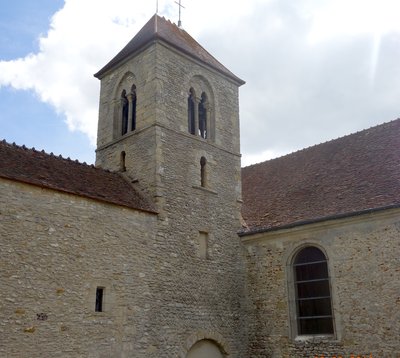
Église Saint-Martin à Folainville-Dennemont - Association Colomban en Brie TouristSaint-Martin Church de Folainville
In the 12th century Pope Innocent II confirmed the donation by William the Conqueror to the Abbey of Saint-Wandrille (Upper Normandy) of the church of Folainville. The bell tower and the annex building which serves as a sacristy remain from this period. The time of the construction of the first church is not known.
Église Saint-Denis à Fontenay-Saint-Père - Fondation du Patrimoine TouristSaint-Denis Church à Fontenay-Saint-Père
The seigneury of Fontenay was given to the abbey Saint-Père-en-Vallée de Chartres in 974.
Placed under the patronage of Saint Denis, the church of Fontenay, dating from the 12th century, is composed of a flamboyant nave with three narrow aisles, whose vault was redone in the 16th century, with a framework still visible in the attic, and a Romanesque choir with a polygonal three-sided apse. The 12th century bell tower is illuminated on each side by two semicircular bays. The facade was redone in 1885.
L’église Saint-Séverin à Oinville-sur-Montcient - Mairie d’Oinville-sur-Montcient TouristSaint-Séverin Church à Oinville-sur-Montcient
The north wall of the nave dates from the construction of the church in the 12th century. Traditionally in Vexin many churches have a bell tower at the crossing of the transept, the church of Saint-Séverin is no exception to this tradition. To the east of the transept, the choir consists of a square bay and a polygonal apse of the Renaissance, which is only remarkable for the baroque stone altarpiece it contains, and its decoration on the outside. Unequal side chapels occupy the corners between the transept crossbars and the choir. The northern chapel is thought to date from the 13th century, with a somewhat rustic Gothic architecture, and the northern chapel displays the style of the late Flamboyant Period, shortly before the mid-16th century. The nave and its side aisle are in the flamboyant style, and are fairly representative of the post-Hundred Years War reconstruction in French Vexin.
Église Saint-Sulpice à Seraincourt - Monumentum.fr TouristSaint-Sulpice Church à Seraincourt
The church, a listed municipal building, is remarkable for its vaulted choir and barrel vault (late 11th century) and for the geminated bays of the bell tower (12th century) topped by a gabled roof.
This Romanesque bell tower, one of the oldest in Vexin, rises above a ribbed vault on four massive pillars decorated with variously sculpted capitals.
The 13th and 14th century chapels, the nave rebuilt between 1857 and 1863, illustrate the developments linked to the development of the history of the village.
Placed under the name of Saint-Sulpice, the parish was served until 1793 by the canons regular of the Order of Premonstratensian founded by Saint Norbert. At present it is part of the parish sector of Fontenay-Saint-Père, diocese of Versailles.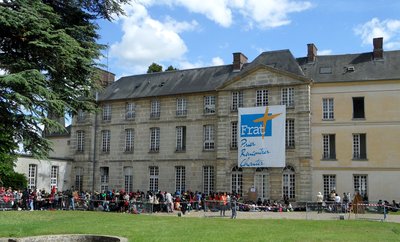
Château de Jambville, lieu de rencontres chrétiennes - FRAT en Ile-de-France HistoricalJambville Castle
Jambville Castle is based on 13th century vaulted cellars and replaces a first castle from the 14th century.
The second castle was built in the 17th century around the tower with a spiral staircase. In front of this building was a French garden. In the 1760s, the de Maussion family, whose arms still decorate the castle, bought the property and transformed it entirely.
The castle was enlarged and the main body was built with its two pediments. The building is then oriented north-south. The French garden is replaced by an English park decorated with follies (decorative monuments) such as the Greek temple, the pheasant pond or St Damien. The avenue of lime trees is then created to give this magnificent perspective.
Today the castle has been a training centre for the Scouts and Guides of France since 1952.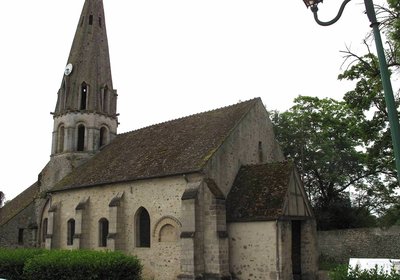
Église Notre-Dame de l’Assomption à Jambville - Fondation du Patrimoine TouristThe construction of the church of Jambville took place between the 11th and 16th centuries. Originally consisting of a Romanesque, timber-framed nave, a bay under the bell tower and a square choir, it was extended at the end of the 13th century with a chapel to the south and a large stone spire, then in the 16th century with a second nave to the south. The church was then vaulted and paved with the current red tiles. Notre Dame de l'Assomption is thus a good witness of the transition from Romanesque to Gothic. The Romanesque octagonal bell tower and its Gothic stone spire are today the only elements worthy of interest outside. Inside, the nave and its side aisle vaulted at the same height form an almost homogeneous whole in the flamboyant Gothic style. The base of the mid-12th century bell tower and its southern crosspiece (13th century) are of a beautiful effect thanks to a skilful restoration, which erases the mutilation of the capitals and the irregularities thanks to the reconstruction of the architectural polychromy in the taste of the Middle Ages.
Description
In front of Notre-Dame de Vétheuil church, take the stairs to the right of the building, place de l'Église, the staircase to rue de l'Église, second street on the right, rue du Bourg, on the left chemin des Noues, second dirt road on the left going up on the edge of the wood, red and white markings, stay on the main road, chemin de la Désirée.
- In Saint-Martin-la-Garenne, second street on the left, rue de la Charielle, straight ahead on a dirt road, turn right at the fork, red and white markings, on the left crossroads with asphalt road, chemin de la Croix Maurice, second road on the right between the horse riding arenas, chemin des Criquetières `
- At the crossroads on the left, enter Follainville, at the crossroads of the asphalt roads straight ahead slightly on your right, Pasteur street, left Wilson street, after the church on the right and left, du Bois street, at the entrance of the woods second road on the right in front of you, straight ahead at the crossroads in the forest.
- Turn left at intersection D983, right C2, enter Fontenay Saint-Père, rue de Mantes, at the crossroads, rue Pasteur in front of you, at the church on the left then right, rue Pasteur, at the crossroads straight ahead rue de la Mairie, rue de l'Ancienne Mairie, straight ahead on the dirt road to the last houses, red and white markings.
- Turn left at the crossroads with C1, road from Breuil-en-Vexin to Guitrancourt, at the crossroads turn right along the old quarry. Crossroads D130, relay radio, straight ahead slightly on the left, on the right route de la Chartre, on the left dirt road in the woods
- Follow the red and white signs, straight ahead at the crossroads Chemin de Juziers to Oinville, straight ahead at the next crossroads, right at the next crossroads, left at the next crossroads, leave the road at the crossroads, exit the woods.
- At the X-intersection on the left, follow the red and white signs, enter Oinville-sur-Montcient, straight ahead in rue de la Mathurine, rue de l'Église, after parking in ears of corn on the right, take chemin piétions on the right with a few steps, la Coulée Verte, on the left, chemin des Moines, on the right, rue de Gournay.
- Left on the D 913, route du Vexin, right on rue de la Nourrée, turn left, sentier des Perdreaux, cross the rue de la Nourrée, right in front of the fields, chemin des Plaignes, left on chemin de la Roue Sèche, rue de la Bernon, leave the red and white markings.
- In Seraincourt, cross the rue des Vallées take the rue de la Côte Derise, sentier du Marais du val, left at the crossroads, you arrive in Jambville, left in rue Moustier, left in front of the castle and the church Notre-Dame.
- Departure : Notre-Dame Church, 13 rue de l’Église, 95510 Vétheuil
- Arrival : Notre-Dame Church de l’Assomption, place de Mgr Colson, 78440 Jambville
- Towns crossed : Île-de-France
Altimetric profile
Report a problem or an error
If you have found an error on this page or if you have noticed any problems during your hike, please report them to us here:
Close by5
- Accommodation





